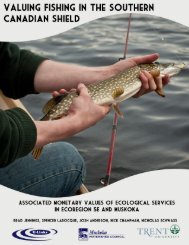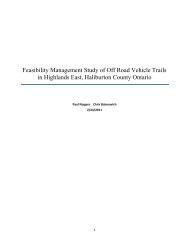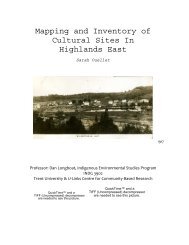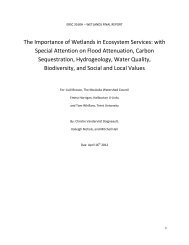Kennisis lake cbe_docx - Haliburton County Community ...
Kennisis lake cbe_docx - Haliburton County Community ...
Kennisis lake cbe_docx - Haliburton County Community ...
You also want an ePaper? Increase the reach of your titles
YUMPU automatically turns print PDFs into web optimized ePapers that Google loves.
Water Quality Indicator Trends Through Time in <strong>Kennisis</strong> Lake, <strong>Haliburton</strong><strong>County</strong>.By: Tyler Vandermolen,Trent University.
Table of Contents.1. Project review.2. Goals3. Background information of <strong>Kennisis</strong> <strong>lake</strong>3.1- History3.2- Water quality concerns in Shield, Unbuffered, Oligotrophic <strong>lake</strong>s4. Data Quality. Data Acquisition5. Phosphorus and Chlorophyll A and Secchi depth- history of use, significance and effects.6. Rationale7. Methods8. Results8.1- Figure 1 TP trends over time8.2- Figure 2 Secchi depth trend over time8.3- Figure 3 Comparison of area <strong>lake</strong>s9. Discussion of results9.1- TP9.2- Secchi10. Other factors and <strong>lake</strong> health, Macrophytes11. Summary
1. Project review.This project was undertaken by partnership of U-links <strong>Haliburton</strong> and <strong>Kennisis</strong> <strong>lake</strong>residents along with a Trent student and professor. A collection of data relevant to <strong>lake</strong>water quality and ecosystem health was amassed and sought to be analysed. Analysisserves to visualize trends overtime so that knowledge might be put to use in managementand stewardship.2. GoalsHere is a short review of the goals of this assignment which serves to explicate thefollowing report. It was requested that visuals were made of certain factors affectingwater quality of <strong>Kennisis</strong> <strong>lake</strong> over time. Such particular factors requested werephosphorus, the limiting nutrient for phyta or plant species and of those, the mostconcerning, the algae’s which proliferate and ‘choke’ the <strong>lake</strong> and other species. Anotherparameter was secchi depth, an indexing tool to measure clarity or turbidity or lightattenuation, the affecting factor of secchi depth is suspended particles, most often algae.The interest for looking at these factors likely came from interest in water quality andecosystem health in relation, possibly, to the effects of affecting activities in the area orthe assessment of successes in mediation actions. Further selection of these factorsexclusively came from a lack of other data over time. This is likely due to the fact thateutrophication wrought by algae and often represented in secchi depth when apparent, isof greatest concern and therefore is widely monitored. As these variables were availableand others not and after analyzing there relationships, other confounding factors wereapproached through history, and their likely effects via literature in review of studies
done in the past, as well as area facts and observation. The result is a discussion of thepossible dynamics of the <strong>lake</strong> in reference to the few trends at hand. More precisely put,the question guiding my research became: what is affecting the water quality indicatorvalues and trends? This question is inclusive of the trends themselves and the elucidationof effectors.3. Background information-History3.1- No doubt much of the recent relative history is known to the residents of the <strong>lake</strong> andtherefore this quick note is to acknowledge the most relevant actions to the data at handand as a formality. <strong>Kennisis</strong> <strong>lake</strong>’s development history is recent in comparison to other<strong>lake</strong>s in the area and specifically those looked at for figure 4, the comparison on area <strong>lake</strong>total phosphorus levels. Development of the <strong>lake</strong> is one of the most relevant factors interms of impermeable or less permeable surfaces as well as sewage and phosphorus orother nutrient rich additions to the <strong>lake</strong> such as iron. Another effect on <strong>Kennisis</strong> <strong>lake</strong>necessary to recognize is the decreasing quantity of acidic rain, which in <strong>Kennisis</strong> islikely very slowly beginning to show effects on shield <strong>lake</strong>s in this area. One of theeffects of acidification is an increase in water clarity which is of interest to our secchidepth record, possibly showing a recovery from acid effects with decreasing clarity.Unfortunately this phenomenon is not well understood and any discussion is suggestivein nature.Characteristics
3.2- Lakes are individual in nature, however in basic characteristics they are often similarto other <strong>lake</strong>s in their area and sometimes to other <strong>lake</strong>s within climate like and geologicareas, sometimes spanning vast distances. For our interest, <strong>Kennisis</strong> will be described inbroad terms with some comparison to local <strong>lake</strong>s or those with a more global nature forcontrast. The most significant deviation from this method is the descriptor; shield, whichrefers to an array of affectual characteristics all relating to the structure of the bedrockwhich is spread across northcentral well into eastern Ontario. The shield provides deep<strong>lake</strong>s and nutrient poor <strong>lake</strong>s due to the lack of erosion of granite both in terrestrialwatershed and within the <strong>lake</strong>. Further, granite <strong>lake</strong>s in Ontario are much more acidicthan calcium rich <strong>lake</strong>s to the south, due to the calcium rich bedrock and soft nature ofthe rock. The following is a list of descriptors which suit <strong>Kennisis</strong> Lakes’ characteristics,their descriptions serving to explain the significance of the <strong>lake</strong>s characteristics to scienceworking with the data parameters here. Also, this section, though lacking some depth indiscussion, can and will be referred to in later sections. <strong>Kennisis</strong> easily resides in thecategory Oligotrophic, meaning nutrient poor, poor referring to quantity. Not only does<strong>Kennisis</strong> lie in an area of many Oligotrophic <strong>lake</strong>s but within <strong>lake</strong>s it contains fewernutrients. In this area an Oligotrophic <strong>lake</strong> has. Whereas a <strong>lake</strong> of medium nutrients,mesotrophic, has and a Eutrophic <strong>lake</strong> would have. <strong>Kennisis</strong> is also a relatively comparedto <strong>lake</strong>s such as the Kawarthas.4. Data Quailty and AcquisitionThe initial data provided for this project spanned considerable parameters beyondthose used such as dissolved oxygen and ph or acidity. These parameters are useful in
identifying relationships between factors and are also useful in witnessing their trendsthrough time as they are often pertinent to <strong>lake</strong> health. Unfortunately, however, the initialdata set was not consistent with parameters sampled, sampling time, or date. In light ofthis and in review of the goals which were to look at phosphorus and secchi depth, newdata was sourced from the <strong>lake</strong> partner program database on the Ministry of Environmentwebsite. Here too there was an issue with phosphorus testing methods changing but thedata was still more consistent. Unfortunately the <strong>lake</strong> partner program only covers totalphosphorus and secchi depth and so the project becomes more limited in scope, yet theseare the most pertinent factors and the ones requested by the host.5. Review of Phosphorus/Chlorophyll A and Secchi depthPhosphorus has been established as the limiting nutrient for algae growth in many casesof eutrophication many of these similar to <strong>Kennisis</strong>. It should be acknowledged thatsome, maybe few, people still discuss nitrogen as a limiting nutrient. A testament to theimportance of phosphorus is it being one of two parameters tested for across Ontario.Phosphorus acts in algae bodies as an energy carrier in exchanging energy in varioussystems including photosynthesis systems. Alternatively, nitrogen is used for amino acidsand the like, essential biological structures. Nitrogen is nearly always in greaterabundance and where it is not there are bacteria algae which fix nitrogen and thereforeovercome any shortage of nitrogen, however rare.High phosphorus causes high algae growth and decrease in water quality along withmany other concerning factors. One such factor is fish kills, due to low dissolved oxygenas bacteria use oxygen while decomposing algae matter.
Phosphorus is measured as total phosphorus (TP) and this includes both particulatephosphorus, usually a higher value, and soluble phosphorus or reactive phosphorus,which is often involved or recently incorporated into biological systems. In bio systemsphosphorus equates to chlorophyll A, a pigment used in capturing light energy but alsocorresponding to a majority of photosynthetic and dominant algae. Due to the closerelationship between these two factors and that one is often used as an indicator of theother, they are used interchangeably throughout the analysis and any points ofdiscussion.The purpose for the use of secchi depth and TP together is that they usually have avery strong relationship. Algae growth decreases light penetration and increasesscattering while of course absorbing much light through photosynthesis. Secchi depth canbe indicative of many things, not just tp levels, and so provides an indication of otherfactors where tp and secchi depth are not correlated in precautionary testing ormonitoring.6. Statement of RationaleThe purpose of this project is to present data on the <strong>lake</strong> to interested parties as itappears to science. Visualized trends can be used to assess concerns on <strong>lake</strong> quality andthrough placing them within a sensible context.7. MethodsData extracted from the <strong>lake</strong> partner program data set and supplementary data from theMinistry of Environment from the Dorset Lakes Centre was collected and organized into
three areas of testing; the east end, mid <strong>lake</strong> deep spot and 999999). These values forsecchi depth were, where applicable, averaged per month and ordered chronologically.The resulting figure lacks yearly values from 1998-2005, the effect of which is anexaggerated decrease visually but the values remain real. This same lack of secchi depthmakes difficult the comparison of TP and secchi depth values. For TP, yearly averageswere used and outliers, often values from months which were not tested for in otheryears, were excluded from analysis. Pre-2000 values were amassed into one average perarea due to the change in testing practices after 1999 and the variation inherent to pre-2000 testing. Before this date chlorophyll (Tp) was collected without a filter on the vesseland so the collection of zooplankton, which are still difficult to see by eye and are muchlarger than phytoplankton, were often included in the tests, resulting in impossibly highvalues of phosphorus. These high values were excluded from average calculations yetother values still may have been affected by particulate and the like, not indicative ofphosphorus. Therefore the MOE still instructs that these values be used as one averagevalue and that the resulting 10 or less data points be not used in analyses over time instatistical tests. This is due to the inherent variation from other factors. For this reason thevisuals must be considered suggestive and correlations are exempt from here.For the comparison of other area <strong>lake</strong>s many inter <strong>lake</strong> factors are controlled for, or keptconstant, by using data from the same month and year.
8. Results and Visuals8.1Figure 1. Total phosphorus values as a measure of nutrient state over eight years butalong with average data pre 2002.Figure 1 shows at the left, an average of each the stn C data and mid <strong>lake</strong> data from allrecords pre-2002. The lines show variation over the preceding eight years. Pre-2002averages are between 3.5 and 4.5 ug/l. Post- 2002 data points vary between 1.5 and7ug/L.
8.2Figure 2. Secchi depth or clarity/turbidity over 10 years above and eighteen yearsbelow. Data points correspond to one per month from may through September with someexceptions, many missing data points and some entire years.
8.3Figure 3. Comparison of Total Phosphorus in area <strong>lake</strong>s adjacent to <strong>Kennisis</strong>In figure 2 the upper graph shows much greater variation and the trend line is nearly flatwith an overall decrease of about 1 metre in clarity. The lower graph shows less variationoverall with more at the beginning of testing. The trend line shows a decrease in averagewater clarity of about 3 metres. The difference between the earlier data 1981 at about 4.5metres and the later data in beginning at 9.5 metres implies that there was an increase of 5metres in water clarity in the interim 14 years. Figure 3 shows the differences in totalphosphorus values between adjacent <strong>lake</strong>s. <strong>Kennisis</strong> is the least enriched while little<strong>Kennisis</strong> is medial and overall difference in value between the highest value and <strong>Kennisis</strong>is about 4.5ug/l.9. Discussion of results.9. Secchi depth visualized over time shows a decrease from 1971 to 1981, followed byan increase over 1981-1992. This spike in value is extreme due to the gap in recorded
values, and the actual increase was likely much more gradual but sample data from 81-92is not available. It is possible that the increase is due to the different sampling methodsand materials, especially as values decrease over time in both data sets. The other obviouspossibility is that the increase is due to acid rain and the resultant clarity. The precedingyears show a slight decrease but mostly stability whereas the years after the increaseshow a greater rate of decrease. However it is still merely suggestive and not concerningto many persons or to ambient literature standards. In analysis of <strong>lake</strong> partner programdata from <strong>Kennisis</strong> <strong>lake</strong> the MOE states that variability and slight changes over time aredue to volunteer perceptions and so this should be kept in mind when assessing otherpossible factors.Returning to ph and acidity, acid rain effectors, predominately SO 2, were reducedand the effects halted. Therefore it could be that the decrease in clarity is a slow return tonormal values as the <strong>lake</strong> and surrounding terrestrial environment is largely unbuffered ordoes not contain basic material which neutralizes the effects of acid deposition. Acid rainand their effect reductions are difficult to calculate. In this case, a few ph samples fromthe <strong>lake</strong> at 6.83 reveals a very normal value and <strong>lake</strong> as acidic <strong>lake</strong>s are below 6 andalkaline are above 8 and so effects may not be present. The effect and recovery on <strong>lake</strong>sis still not completely understood and so comments are lacking here.Total phosphorus shows stability over time with some variability but all variability isstable as well over time when considering pre-2002 data. An average value is (00) andthis is well below many estimates of concern along with values available for tp levelswhere other <strong>lake</strong>s have eutrophied.
Correlation attempts of TP and secchi depth, a correlation which would show therelationship and strength of any relationship, statistically, failed due to the stability andlow nature of values. Further, the fact that secchi depth is more prone to error adds todifficulties in performing such statistical tests. From secchi and Chl A data from 71-81May through September values andwithin single year values were used and east basin test site data from the <strong>lake</strong> partnerprogram inter year from may values only were used. All attempts yielded no relationship.Due to the lack of relationship it needs to be considered that there may be other factorscausing the decrease in secchi.Two factors which remain as possible affectors of clarity are dissolved organic carbon(DOC) additions to the <strong>lake</strong> and an affector therein but that which maintains othermechanisms as well; climate change and/or variability. DOC comes from degrading ordecomposing biological material in the watershed and appears as tea coloured water orbrown water on a sliding scale of intensity. Largest contributors are wetlands, theiremissions controlled by rainfall. Other sources are not as localized and are generallyforested areas. When cleared or disturbed, DOC release increases for a time thendecreases as the resources are exhausted. Contributing factors to doc access can beshoreline changes and watershed changes that promote DOC mobility and allow it to beeasily carried to <strong>lake</strong>s by rain events.Reviewing development history in the area yields little record of intensity of theforestry in the area. It appears that primary removal was early pre-1900 and mills wereabandoned pre-1970, then re-established recently in 2009, it is the <strong>Haliburton</strong> forest. Thistimeline does not necessarily parallel forestry intensity but suggests other sources.
The record of secchi depth spans 1971-2010 with some sizable gaps in records but inevery case a decrease is identifiable. During this same timeline, development of cottagesand roadways as well as intensity of activity has increased as an estimate and thereforemay explain increased DOC or suspended sediments. A contributing factor to those justdiscussed is climate change and variability. The most easily relatable mechanism here isvariability. Greater frequency of intense rain events can drive up the amount of DOC andsediment. High rainfall saturates upper layers of soil allowing other rainfall to flowoverland. This is compounded by less disruption of terrestrial water flow to the streamsand water bodies due to clearing and disturbance as consequences of construction andactivity. It is easy to imagine a correlation of amount of development to the claritydecrease as they have similar trends. Climate change is a difficult array of effects fromwhich to elucidate a mechanism as it requires much data and consideration but it is anarea of future research and possibly interest to <strong>Kennisis</strong> <strong>lake</strong>. Indeed, research withinOntario is yielding results.To add to the climate change and global change arena of potential factors it seemsappropriate to mention wind deposition and disturbance as increased intensity can stir up<strong>lake</strong> sediment in spring and fall to a greater degree. Notably, this is usually reserved forshallow <strong>lake</strong>s, which <strong>Kennisis</strong> is not. More disturbance regionally and globally can resultin more mobile sediment in the atmosphere, compounded by dry periods which areincreasing in intensity.Another effect of atmospheric carbon and dust or other matter, including moisture, is adecrease in light intensity of certain wavelengths. Such decrease would directly altersecchi depth readings as less light would result in less reflection.
In consideration of TP as a strong correlate to Chlorophyll, <strong>Kennisis</strong> appears veryhealthy and even seasonal variations in TP would likely not result in eutrophied waters.Nutrient richness in shield <strong>lake</strong>s in commonly framed at between 11 and 20 ug/L as thearea of concern, note that <strong>Kennisis</strong>’s highest value is about 7ug/L. To further this point,from some <strong>Haliburton</strong> and Minden area <strong>lake</strong>s an average TP value is 9ug/L which is wellabove <strong>Kennisis</strong> <strong>lake</strong>’s maximum value. The observed clarity decrease is likely not areflection of a Chlorophyll A increase, acidification recovery or forestry practices. Theseexclusions then point to atmospheric contents, local erosion through shoreline land usechange, and climate variation as the potential and likely drivers of the clarity decrease onabroad level. These factors do not amount to understanding the mechanisms or thecomplex nature of a minor decrease. The decrease observed is very slight and is not causefor great concern, indicating that natural variation could have a considerable hand in theeffects observed. Additional support for <strong>lake</strong> health comes from assessing figure 4: Acomparison of area <strong>lake</strong>s chlorophyll A levels as it is seen that <strong>Kennisis</strong> has some of helowest algae production in the area.Other factors, Macrophytes10- This section is meant to discuss some further measures of attention which can aid in<strong>lake</strong> health and combat some effects of nutrient loading. Much of the measures of interesthave been discussed and so only macrophytes remain. Macrophytes as phytoplankton oralgae absorb phosphorus and other nutrients in the same manner thereby mineralizing andremoving them from the water column. They are also decomposed by bacteria and canthereby reducing dissolved oxygen. Plants though provide more diversity of life by nature
of their own speciation and by providing habitat for zooplankton and engaging in otherecosystem functions which support species diversity. Some of the physical influences ofmacrophytes are their reduction of turbulence in wave action and wind by absorbing andtransferring or moderating energy, potentially reducing sediment disruption and drivingdown turbidity in near shore areas. Often viewed as nuisances, macrophytes can beintegral parts of local <strong>lake</strong> ecosystems and are in some areas beginning to return.Summary11- It now seems appropriate to summarize the previous reasoning and also provide a fewthoughts on future research along with recommendations wrought from the data and itsaffectors. The question set about to address was: what is affecting water quality indicatortrends? In light of the strong correlations between Chlorophyll A or TP and secchi depthit was expected that the trends for each would be framed and a correlation obvious. Thestudy elucidated the stability of values of Chl A and the slow descent of clarity and soother factors effecting clarity were sought. It seems that ph and watershed scaledevelopment in logging is not a large factor and so the remaining obvious factors areclimate and local erosion through intensity and land use. The values observed in bothphosphorus and clarity are moderate and are not cause for great concern especially whenmade relative to area <strong>lake</strong>s as well, levels of Chlorophyll A and TP are often cause foreutrophicaion at great values not at the value seen here. It is necessary to recognize thatsecchi and all the intricities of europhication and <strong>lake</strong> health are far from known and varygreatly between <strong>lake</strong>s and areas. Further, <strong>lake</strong> systems and ecosystems in general havelag times or do not always show the effects of affecters immediately but rather, such
effects can occur after a time or along with critical points of some affecter(s). With thisknowledge it seems appropriate to always act with the precautionary principle or withdoubt of what we know. In order to adequately protect our and others <strong>lake</strong> water wemight assume or prepare for negative effects.Further research might include assessment of erosive causes in local areas andwatersheds. By making these values relative to different <strong>lake</strong> values in the area, thestrongest effects of change in secchi depth may become apparent and this could bevaluable in focusing efforts on stemming or moderating those effects. As the cause ofmany of these effects are already widely established, development of tools both socialand scientific can be developed to avoid possible future consequences. Fortunately, aswas seen at the recent u-links fair, some tools are already being developed.
Appendix.Table1. Lake partner program phosphorus means <strong>Kennisis</strong> (ug/L)Mid <strong>lake</strong> Stn C west Eastend2002 4.6 2002 3.3 2004 4.452002 5.1 2004 4.05 2005 3.92004 3.53 2006 3.2 2006 32005 4 2007 2.95 2007 2.22006 2.55 2009 3.2 2009 4.852007 3.652009 5.32010 5 3.3Table 2. Phosphorus ug/LTotal Phosphorus averages May 2007East 6.9 <strong>Kennisis</strong> 2.53Kennegawa 3.36 Kawagama 3.36<strong>Kennisis</strong> 2.53 Little kennisis 3.7Little hawk 5 Little hawk 5Little kennisis 3.7 East 6.9Table 3. Secchi depth (metres)Secchi depth 92-10Secchidepth71-81######## 9.0 4.45-Jul-92 7.0 4.819-Jul-92 9.0 3.43-Aug-92 8.0 4.616-Aug- 8.0 59223-Aug- 7.0 4.59213-Jun-93 10.0 7.43-Jul-93 8.0 5.411-Jul-93 9.0 5.618-Jul-93 11.0 5.72-Aug-93 11.0 3.58-Aug-93 10.0 622-Aug- 8.0 59329-Aug- 8.0 4.5936-Jun-95 8.5 5
25-Jun-95 9.8 5.730-Jul-95 10.0 69-Aug-95 7.5 6.513-Aug- 7.3 6.9952-Sep-95 9.8 6.51-Jul-96 9.5 4.514-Jul-96 9.8 5.513-Aug- 8.8 5.5962-Sep-96 7.5 5.51-Jul-97 4.0 5.520-Jul-97 9.8 44-Aug-97 11.0 4.528-Jun-98 8.5 5.53-Aug-98 10.8 6######## 7.5 711-Jun-05 8.0 63-Jul-05 7.0 5.51-Aug-05 8.3 6.514-Aug- 7.6 3.2054-Sep-05 8.4 4.517-Sep- 7.8 3.8052-Oct-05 7.4 5######## 8.4 3.5######## 8.8 4.817-Jun-07 8.1 517-Jun-07 8.1 48-Jul-07 7.4 58-Jul-07 7.4 5.522-Jul-07 7.5 4.522-Jul-07 7.5 411-Aug- 6.8 40711-Aug- 6.8 50726-Aug- 6.9 5.50726-Aug- 6.9 50725-Sep- 6.8 50725-Sep- 6.8 5071-Jul-08 8.2 4.55-Jul-08 8.3 3.520-Jul-08 6.5 43-Aug-08 5.5 3.24-Aug-08 5.8 4.517-Aug- 6.9 5
0831-Aug- 5.9 4.50828-Sep- 6.6 4.5085-Oct-08 7.1 5.518-Oct-08 6.9 6.5######## 7.5 4.55-Jul-09 6.8 4.519-Jul-09 6.9 4.525-Jul-09 6.5 4.53-Aug-09 6.0 4.525-Aug- 6.0 40930-Aug- 5.7 5097-Sep-09 6.3 419-Sep- 7.3 4.5094-Oct-09 6.1 5######## 9.0 5.56-Jun-10 7.4 55-Jul-10 8.0 510-Jul-10 7.4 424-Jul-10 6.0 45-Aug-10 6.0 3.522-Aug- 6.01029-Aug- 6.0106-Sep-10 6.112-Sep- 6.1102-Oct-10 6.923-Oct-10 7.3







